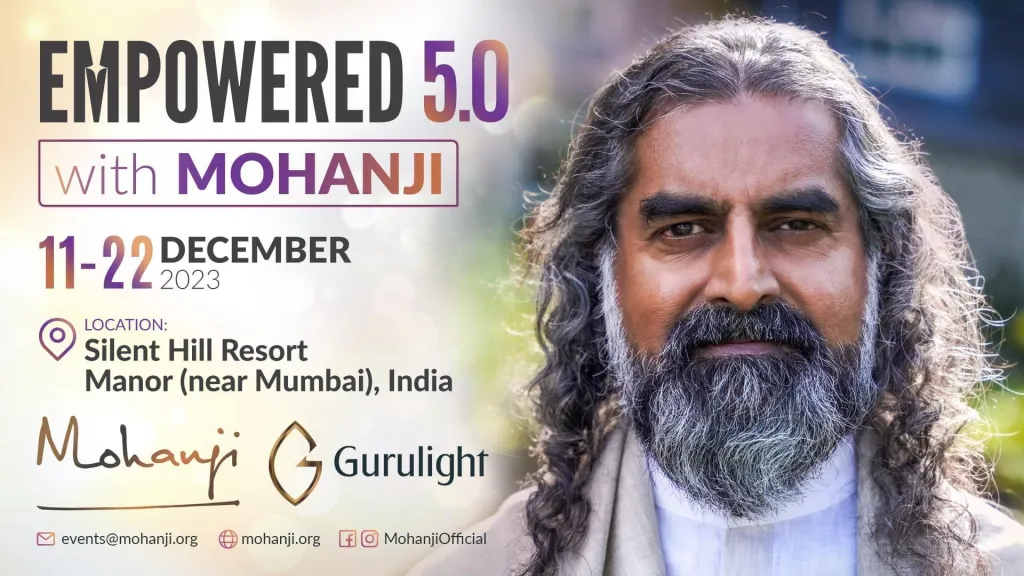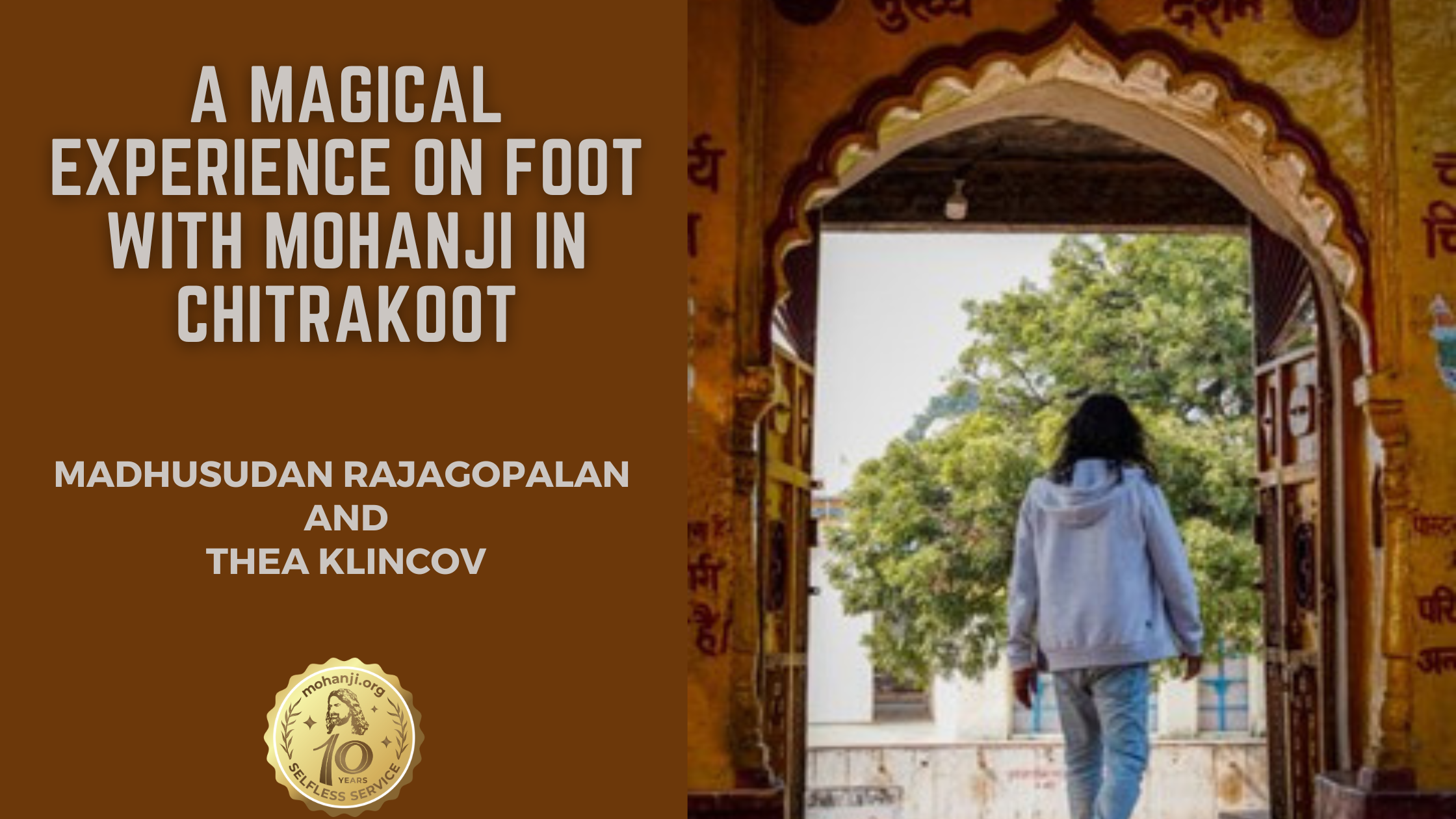By Madhusudan Rajagopalan and Thea Klincov
Introduction
Chitrakoot is well known to readers of the Ramayana [One of the two major epics of Sanatana Dharma (the Eternal Religion)] as the place where Lord Rama (the seventh incarnation of Lord Vishnu), along with his wife, Mother Sita and brother Lakshman, spent eleven years out of his fourteen-year exile. Even today, the town seems to exist in that bygone era, reminiscing the lost days with every corner adorning a shrine of Lord Rama’s durbar (royal court)– Lord Rama seated in his darbar with Mother Sita by his side, his brother Lakshmana behind him and Lord Hanuman at Lord Rama’s foot.
Chitrakoot has found its way in many a Mohanji conversation over the years. Mohanji wanted to experience this place he calls Lord Hanumanji’s ‘home’ since Lord Hanumanji is ever present where his beloved Master, Lord Rama’s name is chanted. In November 2022, Mohanji was finally able to visit this power centre. This blog is a humble attempt to capture our experiences and insights from this short yet action-packed visit.


Chitrakoot – A Background
Chitrakoot is a picturesque town nestled amidst forests and hills. The town is replete with images and chants in praise of Lord Rama. Murals with images of the Ramayana adorn the walls while the sacred chants ‘Jai Siya [Siya is Sita in the Awadhi Hindi language] Ram’ (Hail Mother Sita and Lord Rama and ‘Jai Shri Ram’ (Hail Lord Ram) fill the air. The myriad ashrams dotting the town and the throng of saints and mendicants – both local and wandering- on the streets give this town a distinctly spiritual vibe. The beautiful and holy Mandakini river flows through the town, adding to the ethereal feel of the town.
The centre point of this town is the sacred hill Kamadgiri, where Lord Rama is believed to have lived. Kamadgiri, in Sanskrit, literally means “one that fulfils all desires”; hence, a circumambulation of the base of the hill is considered highly auspicious. Devotees believe that all the teerthas (holy places) lie along the route.


Chitrakoot is also synonymous with Lord Hanuman’s presence. As is well known, Mohanji loves and reveres Lord Hanuman as an embodiment of the perfect Master disciple for his unshakeable faith and complete surrender, with full awareness of his stature. Mohanji has explained this beautifully in his blog:
“Lord Ram asked Hanumanji, ‘Who are you?’ Hanumanji replied with total humility, ‘Great Lord, if I knew who I was, I might not be serving you.’ What Hanumanji meant was that if he realised who he really was, then there would be no separation from Ram, as Hanuman and Lord Ram are indeed ONE – two aspects of the same consciousness. There is no servant and no master. There is no expectation. There is no separation. Until this realisation happens, this and that, me and that, he and that, and all other kinds and aspects of separation will exist in the mind.”
Though I knew about Chitrakoot since childhood, I had never visited the place myself. I was excited to experience the place in the presence of Mohanji since that usually unravels some new facets beyond the normal. Thea, our photographer/videographer, was even more thrilled about Hanumanji living in Chitrakoot and particularly the prospect of experiencing Hanumanji in a physical form! Her connection with Hanumanji had happened around a year earlier through a story related by her friend following a Mai-Tri session. Mohanji had recounted this story about the power of Hanuman’s devotion in several of his satsangs, but it clicked and changed something in her only after her friend mentioned it. You can get more details of this story here.
Since then, she has considered Hanumanji as the personification of dedication, selflessness and surrender to one’s Guru. He became both an aspiration and an inspiration. Her friend had told her, “Being with Mohanji, doors open. Without him, they just close in front of us.” She felt we would probably meet Hanumanji due to Mohanji’s presence and grace but was concerned if she would recognise him. In her words, “In this world, the fake seems more real than real itself and sometimes real looks fake. We have to keep our eyes open, ready to perceive the imperceptible.”
Humble Beginnings
Chitrakoot is located on the border of two large North Indian states, Uttar Pradesh and Madhya Pradesh, and involves a long road journey (almost 5 hours) from Lucknow airport. One of Mohanji’s followers, who stayed close to Chitrakoot, had been inviting Mohanji to visit Chitrakoot for almost a decade. When Mohanji confirmed his intention to visit, he made all the necessary arrangements and came to receive Mohanji at the airport. We undertook the mostly uneventful road trip after a sumptuous lunch in Lucknow.
Though Mohanji never seeks special privileges when visiting Masters or power centres, the Tradition ensures to take care of their own. Lord Hanumanji secured extra attention and respect for our group by arranging a car hired previously by local politicians for election campaigning. The ruling party flag on the bonnet with the pictures of the chief minister of the state and the prime minister of the nation on either side was the passport that ensured prompt passage through the intervening checkposts and toll points. Late evening, we reached our cottage in Chitrakoot, welcomed by the gurgling Mandakini stream nearby. Despite the late evening fog blocking the view, the tranquillity was palpable. We settled in, made plans for the next morning and retired for the night.
The Kamadgiri Parikrama
The following morning brought our first glimpse of the holy Mandakini flowing below our cottages, which were situated on an elevated plateau. The surreal early morning setting of a fading fog permeated with chants from nearby ashrams, the gushing sounds of a flowing river, and the occasional chatter of the people bathing in the river created a serene temple town atmosphere that set the mood for the day ahead. After breakfast, we set out with great anticipation and excitement for a parikrama of the holy Kamadgiri mountain and drove to the starting point, the Shri Kamtanath temple. After offering our prayers, we started our parikrama at 9.45 am and expected to complete the well-paved and largely flat five km path at a very relaxed pace within 90 minutes and return for lunch.
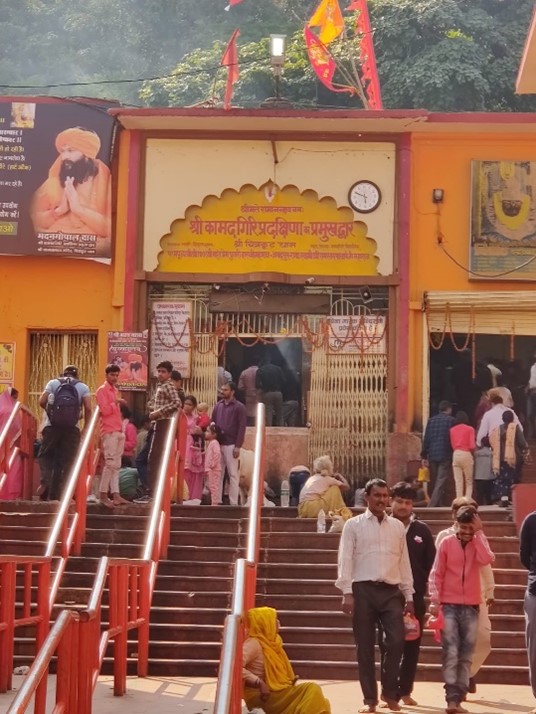
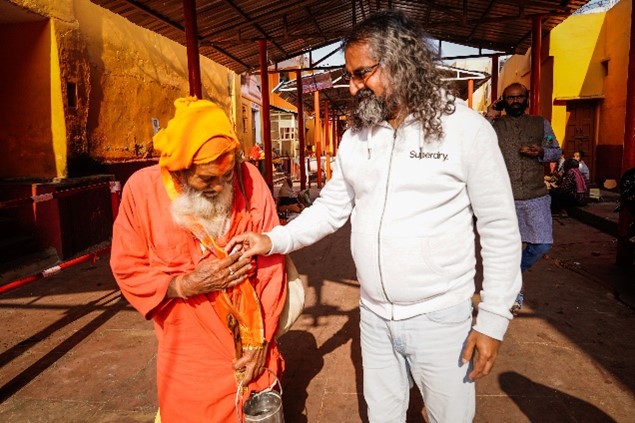
Mohanji had just returned from his overseas travels and was still recovering from a serious car accident in Europe the previous month, when he has to spend almost 3 days in the ICCU. Despite his weakened state, he continued with his busy program schedule and commitments, which prevented proper rest. This was followed by his travel to India and further travels within India. Hence, we were mindful not to exert him as he was still recovering. Before we started, we asked Mohanji if he would like to take the wheelchair services or similar support. However, Mohanji refused any kind of support and insisted that he would walk the whole path. We reluctantly accepted his decision. We felt there was a greater significance to his decision… this would become evident to us later.
The pathway of the parikrama begins to the left of the main temple, with many small shrines dedicated to various deities. We stopped to take their blessings; Mohanji’s pilgrimages are always for the well-being and welfare of all the people associated with him and all the world’s beings. We prayed along those lines and started our walk. Interestingly, the last shrine was dedicated to Shirdi Sai Baba – a reassuring sight for all of us, signalling Baba’s presence with us through the parikrama.




Since there were many pilgrims walking along the busy parikrama path, we brought two bags of biscuits in preparation to distribute to sadhus (renunciates or mendicants) and other beings. Right opposite the Baba temple, there were many old people sitting on the floor waiting for alms. Usually, there is a mad clamour as people feel that there won’t be enough. As we gave biscuits to a man, he loudly exclaimed, “Don’t worry. Everyone will get it. This gentleman has brought lots of biscuits!” We don’t know if he recognised Mohanji or was a saint in a beggar’s guise, but his words were a proclamation that there would be no denial to anyone under Mohanji’s watch!


As we started the parikrama, we fed every being in sight generously – be it a dog, cat, goat, cow, monkey or a human being. We had bags filled with biscuits and bananas. Our local hosts walked with us and arranged the food items to be distributed. They told us that monkeys loved raw brinjals (eggplant). We bought a few kilograms of brinjals from a nearby vendor and gave them to the monkeys. Soon, demand outstripped supply, and we had to engage another push-cart vendor. Given the rate of our distribution, this vendor joined our parikrama group and walked with us all through the path, supplying brinjals as and when needed!

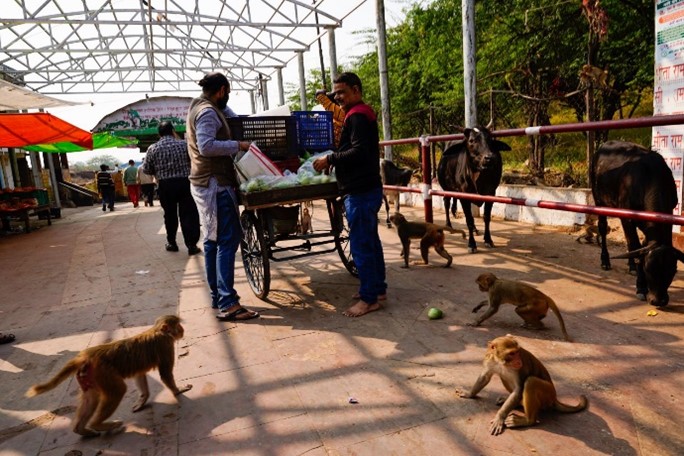
Normally, monkeys can be quite troublesome and scare people. However, they were in extraordinarily good behaviour in Mohanji’s presence, taking food from our hands like little children unthreateningly. Mohanji constantly fed beings at almost every step. He mentioned that animals respond to us as we do to them. If we approach with fear, they respond with fear and aggressive behaviour. As we operated with love and kindness and fed them generously without fear, they mirrored in kind and behaved like ‘good children’. Mohanji would throw bananas or brinjals to one side of the path or onto the boundary walls to make it easier for monkeys to pick up and eat. Some monkeys connected with Mohanji and had an eye-to-eye conversation before scurrying off. Throughout the parikrama, we observed various such exchanges where animals connected deeply with Mohanji, and we had the blessed opportunity to serve thousands of them.
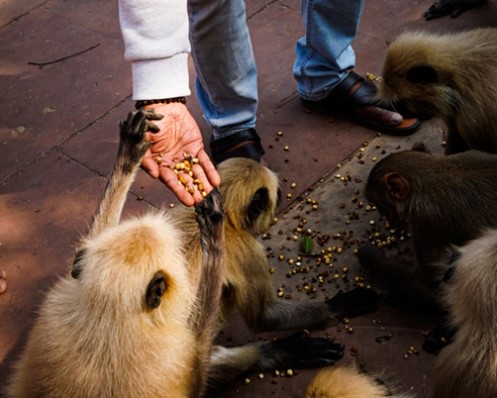
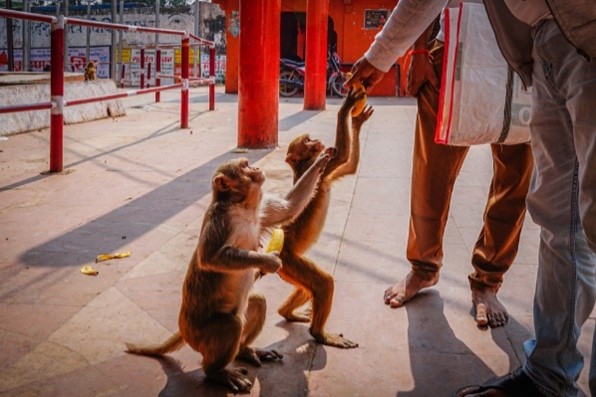
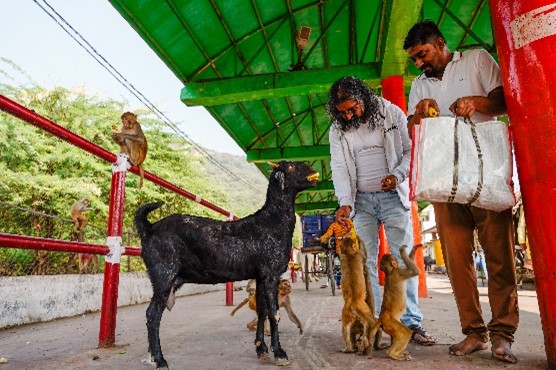
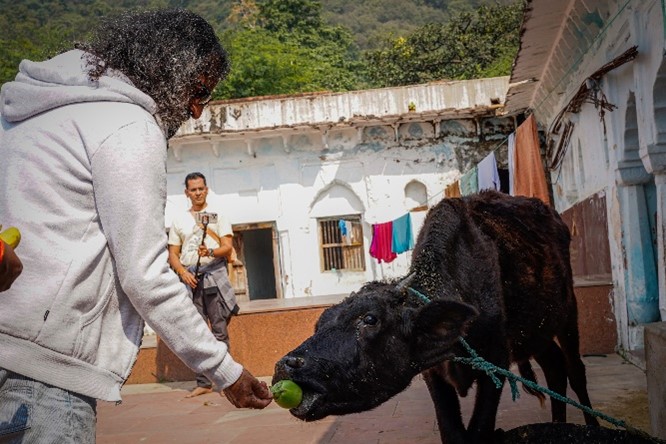
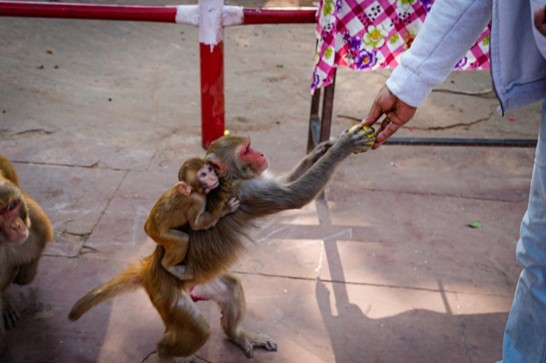
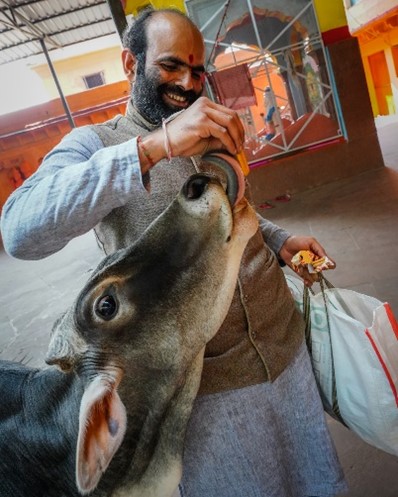
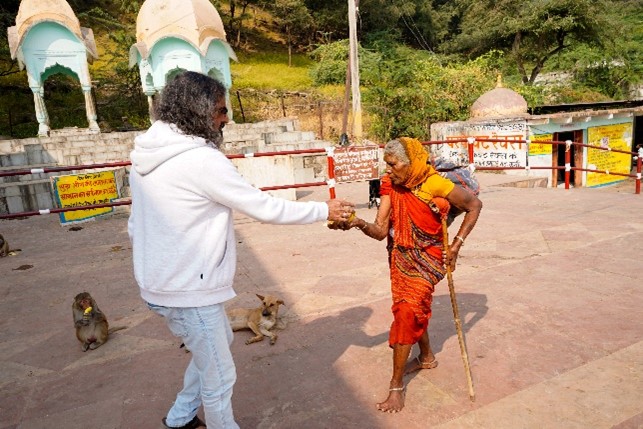
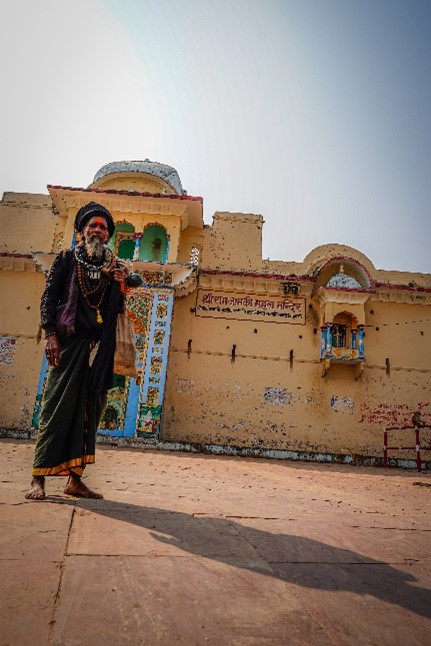
Encounters between Mohanji and Animals
A few episodes were particularly interesting. One monkey swooped down the parapet wall from a high roof, watched Mohanji intently, approached him and collected his banana in one smooth move without letting the banana fall to the ground. Mohanji casually commented, “No more monkey lives for him. He will take a human birth in his next life!” Later in the parikrama, Mohanji took a small detour to feed a calf, staying with him for several minutes longer than with any other animals until then.
This calf ate from Mohanji’s hand to his heart’s fill. As the calf ate, Mohanji shared that this calf, in an earlier human life, had denied food to someone, falling down the ladder of evolution to become a bull. By feeding the calf with his hands, Mohanji nullified the negative effect of that act and helped him progress to a human birth in his next life. Mohanji remarked, “There were many reasons for coming to Chitrakoot. Meeting this calf today was one of them!”

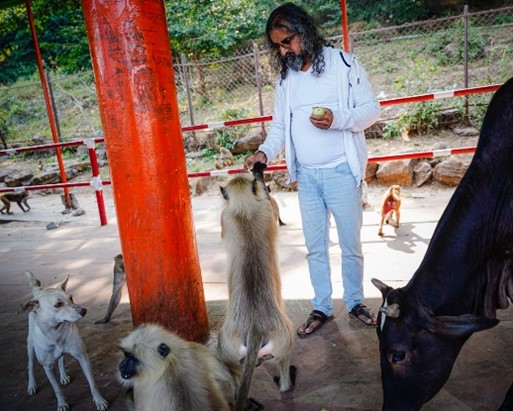
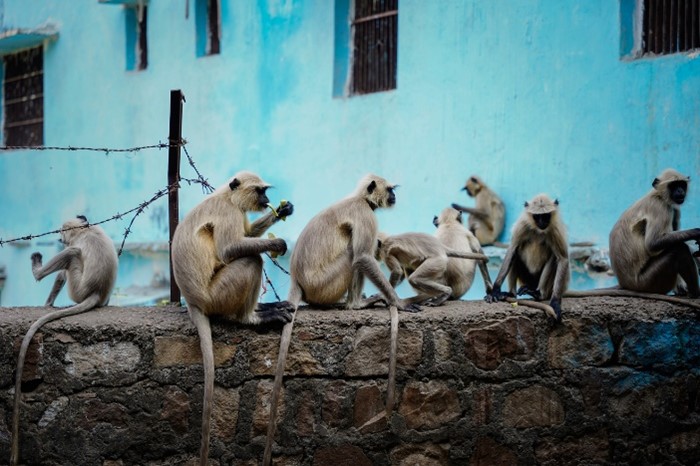
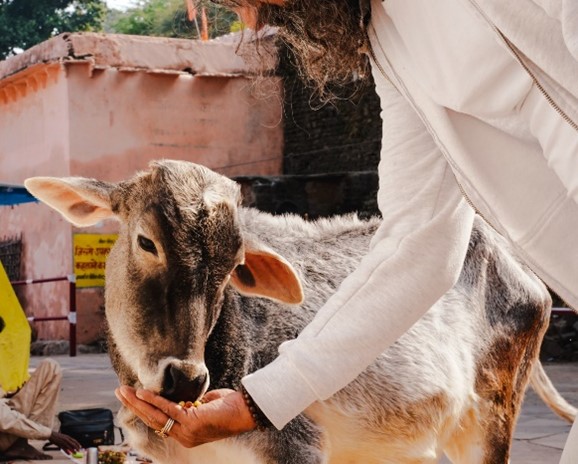
We were in awe of the dimensions in which Mohanji operates. What we see is not even a micro fraction of what he actually does. On the surface, he fed a calf. However, there was so much grace and compassion that went beyond the feeding. Mohanji always says, “No one comes within my presence unless I have something to deliver.” Who knows what else is happening when a seemingly random stranger meets Mohanji even briefly – what immense grace or eligibility brings them to that moment?
They may not realise it, but it is a reminder that we should. Every moment and interaction with Mohanji is an act of grace and an opportunity to raise one’s awareness and operating levels. Taking Mohanji’s friendly behaviour or casual demeanour at face value and taking his time for granted is the biggest mistake one could make. If we miss the bus, he would be none the lesser, but we would have missed an opportunity that we craved for lifetimes!
Another lesson from the above episodes is treating every being with kindness. Mohanji often says that the Tradition of liberation is so powerful that if even one being yearns for liberation, the Tradition sends a Master to fulfil that desire. When we see a being and dismiss it as just another animal, we are unaware of the karmic background. It could have been an elevated human in a past life that reincarnated as an animal due to karmic pulls.
Perhaps a divine being taking an animal form to meet Mohanji and take prasad (consecrated offering) from him. Or just a being going through the daily struggles of survival, hoping for food from a kind being. The bottom line is that our ignorance has no limits, just like Mohanji’s compassion! Hence, the safest bet is to treat all beings with kindness, or at least with no rudeness. Another of Mohanji’s constant reminders is “Never miss an opportunity to serve another being. God and Guru can come in any form!”
During this walk, Mohanji’s kindness was not limited to feeding animals. Our group encountered several sadhus. Mohanji enquired if they needed anything and a few mentioned blankets, given the onset of winter. Mohanji instructed our local host to arrange for a blanket distribution drive to all the sadhus and elderly beings on the parikrama path and other places in the town, which was subsequently completed within a week.
Mohanji also noticed that the monkeys and other animals were often in conflict with the pilgrims. He felt the hill couldn’t provide enough food for the animals, forcing them to stray into human territory. He asked our local team to arrange fruit tree plantation on the sides of the hills so that the monkeys and birds had plenty of food, removing their dependency on passing pilgrims. This project was taken up by our local team in coordination with the local authorities and completed a few months later, post-winter. In this way Mohanji’s parikrama benefited the beings not just on that day but also on a long-term basis.
Connecting with the Ramayana
We also had the opportunity to experience the most sacred historical places and stories from the Ramayana. When we began our walk, Mohanji mentioned that he felt Hanumanji would grace us with his darshan (holy sight) during this parikrama. He didn’t specify how or when, so the unsaid message was to keep our eyes and ears open. Stay ‘alert, aware and active’ as Mohanji often reminds us. The parikrama path is dotted with various temples and shrines of either Masters or deities, with many dedicated to Lord Rama and his darbar.
Midway through the parikrama, we entered a big temple out of curiosity. The temple had the square structure of a traditional house, with living quarters around the perimeter and a spacious central courtyard open to the sun. One had to bow down to enter, due to the low height of the door and cross the courtyard to see the main deities.
There was a niche to the right of the house where an old saint was sitting. We went to him and struck up a conversation. We were amazed to discover that he had custody of the original Rama Charita Manas – the translation of the Ramayana from Sanskrit to the local language by the great saint Goswami Tulsidas that made the great epic accessible to the masses! It was an unbelievable surprise as we were not even aware that the original manuscript was intact.
The book was many centuries old. The saint explained that the Rama Charita Manas consisted of multiple books (referred to as kaand in Hindi, which means section) dedicated to different stages of Lord Rama’s life. These books were preserved in three locations. This temple had 2 kaands, while the rest were distributed between the Tulsi mandir (temple) in Varanasi and a temple at Tulsidas’s birthplace, Rajapur.
The saint fetched the manuscript from his cupboard and laid it on his table, allowing us to touch the well-preserved pages (encased in special sleeves to protect them from decay). He became deeply engrossed, telling us stories of Lord Rama and Lord Hanumanji. Mohanji gestured for us to click pictures of him speaking and particularly to take close-ups of his face. His blue eyes glazed over, becoming almost transparent as he continued talking.
Mohanji listened to him with rapt attention, and a few minutes later, the saint looked away and ended the conversation. We offered him dakshina (an offering to a holy personage, in this case, money), took his blessings and left. As we stepped out, Mohanji asked with a twinkle in his eye, “Did you notice how his eyes changed? Hanumanji spoke to us through him and blessed us.”



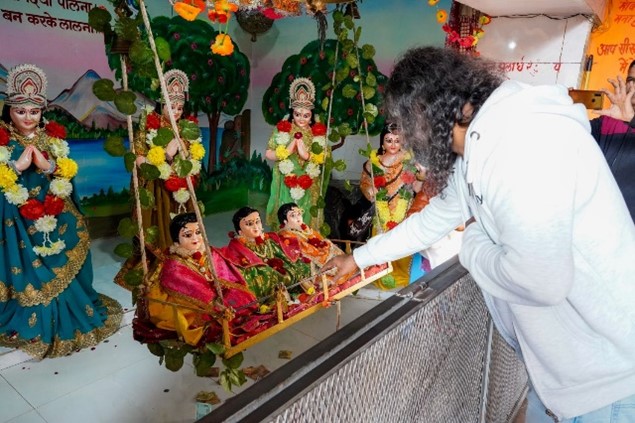


I had noticed a change in the saint’s body language, but my awareness was not strong enough to pick up the subtle changes. When we saw the camera photos, the changes were clear, yet it took time for this incident to sink in. Hanumanji had just spoken to us directly! People spend their lives connecting to Hanumanji and yearning for a sign from him. Our proximity to Mohanji allowed us mere mortals to listen to Lord Hanumanji! My head spins at this thought. Though ignorant of this encounter’s import and impact, we knew a deep transformation happened within us!
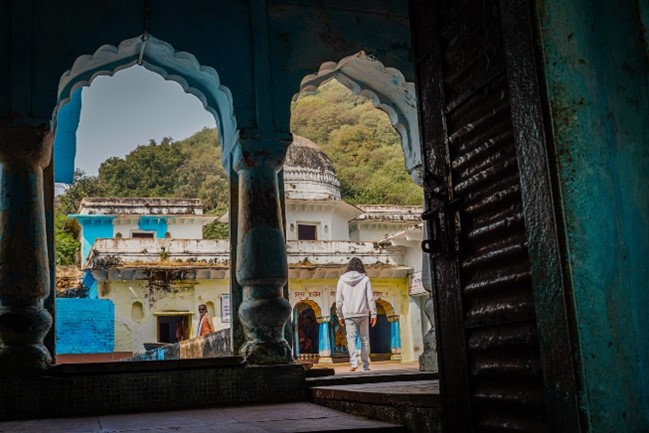

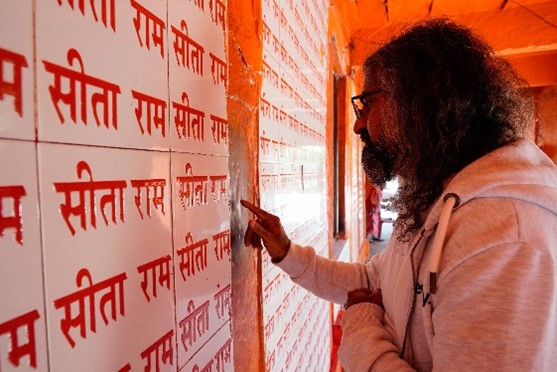

Outside, to the left of the entrance, were shrines dedicated to Tulsidas and his Guru, Narhari Das, on an elevated platform that required a short climb. Due to paucity of time, we paid our respects, bowed down from afar and continued on our parikrama.
Our next stop was at another non-descript-looking temple. The name board ‘Bharat Milap Mandir’ informed about its significance. This is where the younger brother of Lord Rama, Bharata, met his elder brother during his exile and requested him to return as Ayodhya’s ruler, discontinuing his fourteen-year exile. Being under renovation, we couldn’t see all the shrines.
However, the main attractions in this temple were not the shrines but the gopuram (pyramidical spire) structure in the open courtyard that housed rock slabs with the imprints of the feet of Lord Rama, Bharata, Mother Sita, Lakshmana and Shatrughna (another younger brother of Lord Rama), and Lord Rama’s mother, Kaushalya. It is said that the fiery intensity of mutual brotherly love melted the stones, capturing their footprints for eternity.

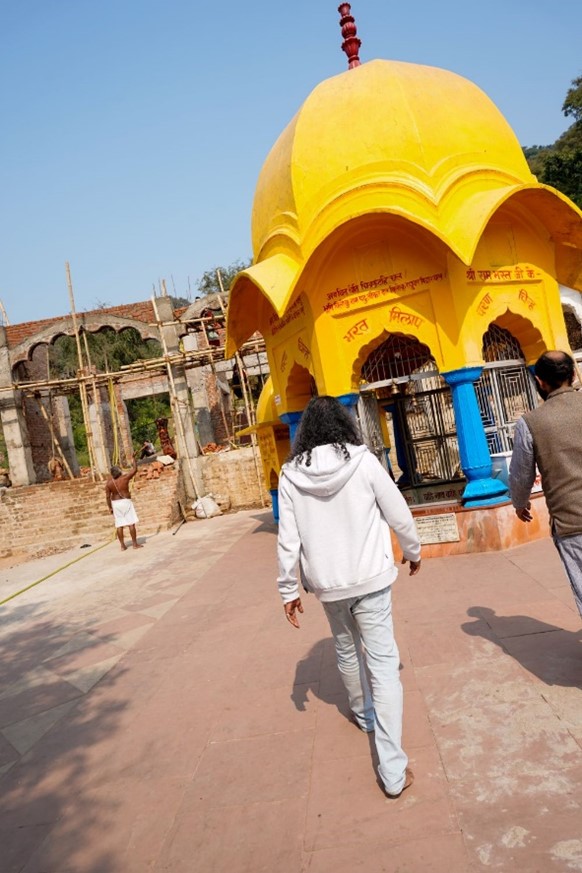
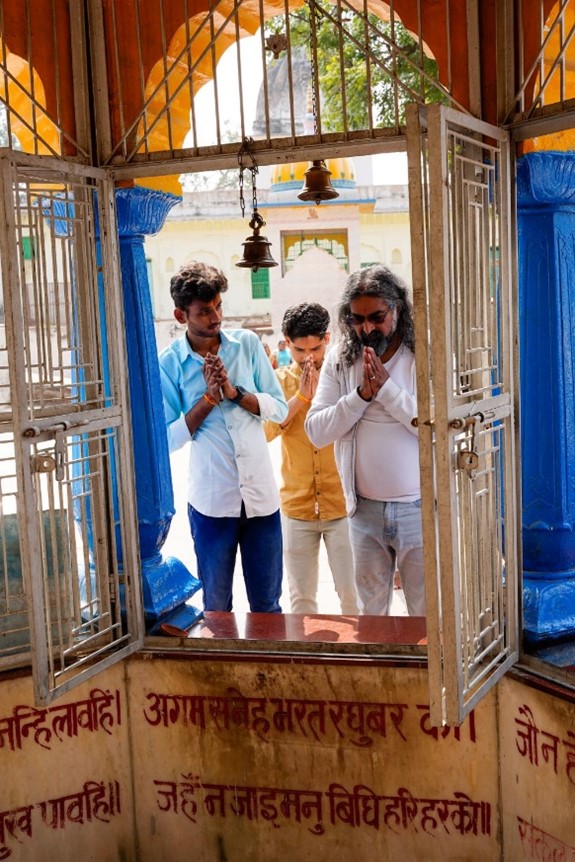
At first glance, one only sees a few stones with imprints. But the story behind the meeting carries incredible lessons. The crown prince, Lord Rama, was asked to go into exile a few hours prior to his coronation by his heartbroken father (King Dasharatha) on the wishes of his second queen, Kaikeyi, to fulfil a promise he made to her. Treating his father’s word as a divine command, Lord Rama instantly leaves the kingdom without a second thought.
His wife Sita and brother Lakshmana follow him since their life had no meaning without Lord Rama. His other younger step-brother, Shatrughna, wants to follow but is asked by Lord Rama to stay behind to take care of his father and his mothers. When his step-brother Bharata (Kaikeyi’s son) returns to Ayodhya and finds out that his mother sent Rama to exile to make him king, he curses his mother and leaves for Chitrakoot to convince his exiled brother Rama to return to the kingdom as the rightful ruler.
Lord Rama, known as Maryada Purshottama Rama (Rama, the lord– epitome or gold standard – of right conduct), counsels and consoles his brother that his father’s words as a parent and king are divine commands for them and cannot be disobeyed. He has to finish his exile, and Bharata has to rule the kingdom. Obeying his elder brother’s words, Bharata agrees to rule the kingdom but decrees that only Lord Rama can be Ayodhya’s king, and he will remain Lord Rama’s mere servant.
He declares that he will serve as Lord Rama’s regent and rule the kingdom on Lord Rama’s behalf until his return from exile. He requests Lord Rama to give his padukas (footwear), carries them on his head with utmost respect and reverence, installs them on the throne in Ayodhya and rules Ayodhya on Lord Rama’s behalf, eagerly awaiting Lord Rama’s return. These padukas are now on a pedestal in Nandigram.
This story exemplifies the highest principles of right conduct:
- King Dasharath honouring a promise made out of gratitude, no matter the personal cost
- Lord Rama’s complete detachment from the trappings of power
- Lord Rama’s absolute respect for his father and king’s words
- Bharata’s absolute love and surrender to his elder brother
- Bharata ruling in absentia, keeping duty and purpose above personal desires
Through these lessons, the place transports us from the mere physical location to a portal of profound insights – it just depends on what we choose to see. It also struck me that Mohanji espouses and exemplifies the exact same principles in today’s world, not through mere words but through his actions and his life. This does not require the study of scriptures or epics to understand, but merely listening to Mohanji’s words, watching his actions and following his guidance like our life and beyond depended on it! Though it is really that simple, how much do we really practise? Food for thought, indeed…
We continued on our way and eventually completed the parikrama. We lost track of time amidst the grand festival of feeding. A mere parikrama and temple visits became a full-fledged interspecies celebration with sadhus, beggars, children and other beings (monkeys, cows, dogs, goats and birds) participating in the festivities, enjoying in unison the food being served to them. In Mohanji’s words, “Feeding the children of Mother Earth is the best way to visit temples and pay respect to the deities.”
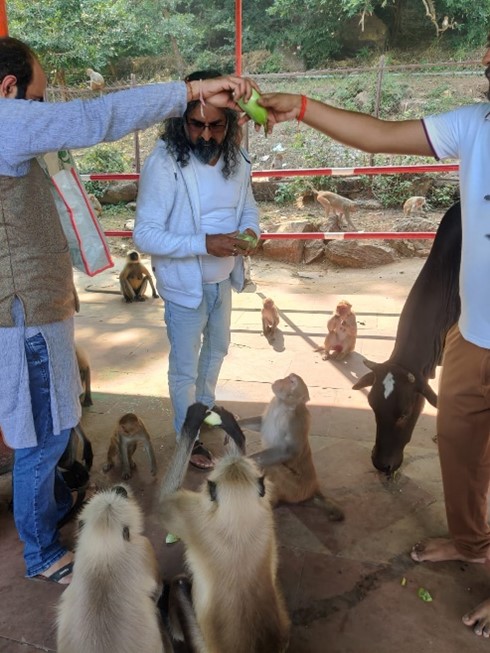
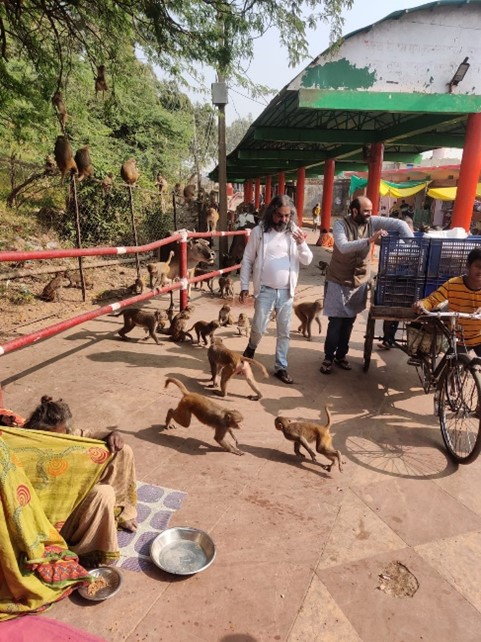
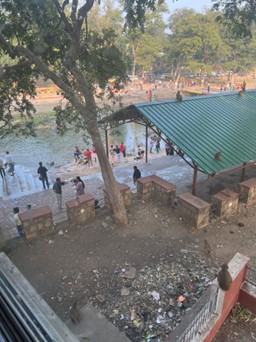
We realised that it took us almost four hours. Besides the temples, we had not taken any breaks or rested anywhere. Yet, we felt incredibly light and happy and not the least bit tired. The cleansing in this high-energy location probably explained it. Mohanji seemed visibly contented and happy! He shared a profound message, “Hanumanji is happy, as we made his people happy. I fed these beings generously without any denial, thus cleansing all our people of the sin of denying food to any being, knowingly or unknowingly, at any point in their lives, past or present!” We felt happy hearing this and also for making so many beings happy! A powerful completion for us and for many in our community!
Conclusion
The Chitrakoot visit and the Kamadgiri parikrama provided an opportunity to connect to the Ramayana epic at a very personal level. Living in big cities, we lose sight of the incredible spiritual heritage of ancient, sacred Bharat. Chitrakoot reminded us that wealth is ever-present and accessible to those who make the effort! It was also a gentle yet powerful reminder of Mohanji’s oft-repeated maxim that the purpose of our life is to add value to the world with every waking moment. When we do that, we change the world through our practice, not precept. Practice what you preach, and then your practice becomes the preaching. Go not in search of Masters or God. Touch the lives of all those who come your way, and Masters and God will come in search of you.
|| JAI BRAHMARISHI MOHANJI ||
Edited & Published by – Testimonials Team, 20th November 2023
Disclaimer:
The views, opinions, and positions expressed by the authors and those providing comments on these blogs are theirs alone and do not necessarily reflect the views, opinions or positions of Mohanji, Mohanji Foundation, it’s members, employees or any other individual or entity associated with Mohanji or Mohanji Foundation. We make no representations as to accuracy, completeness, timeliness, suitability or validity of any information presented by individual authors and/or commenters on our blogs and will not be liable for any errors, omissions, or delays in this information or any losses, injuries or damages arising from its display or use.
We reserve the right to delete, edit, or alter in any manner we see fit blog entries or comments that we, in our sole discretion, deem to be obscene, offensive, defamatory, threatening, in violation of trademark, copyright or other laws, of an express commercial nature, or otherwise unacceptable.
Mohanji Testimonials team
To register for the next Empowered 5.0 in India, click here!
